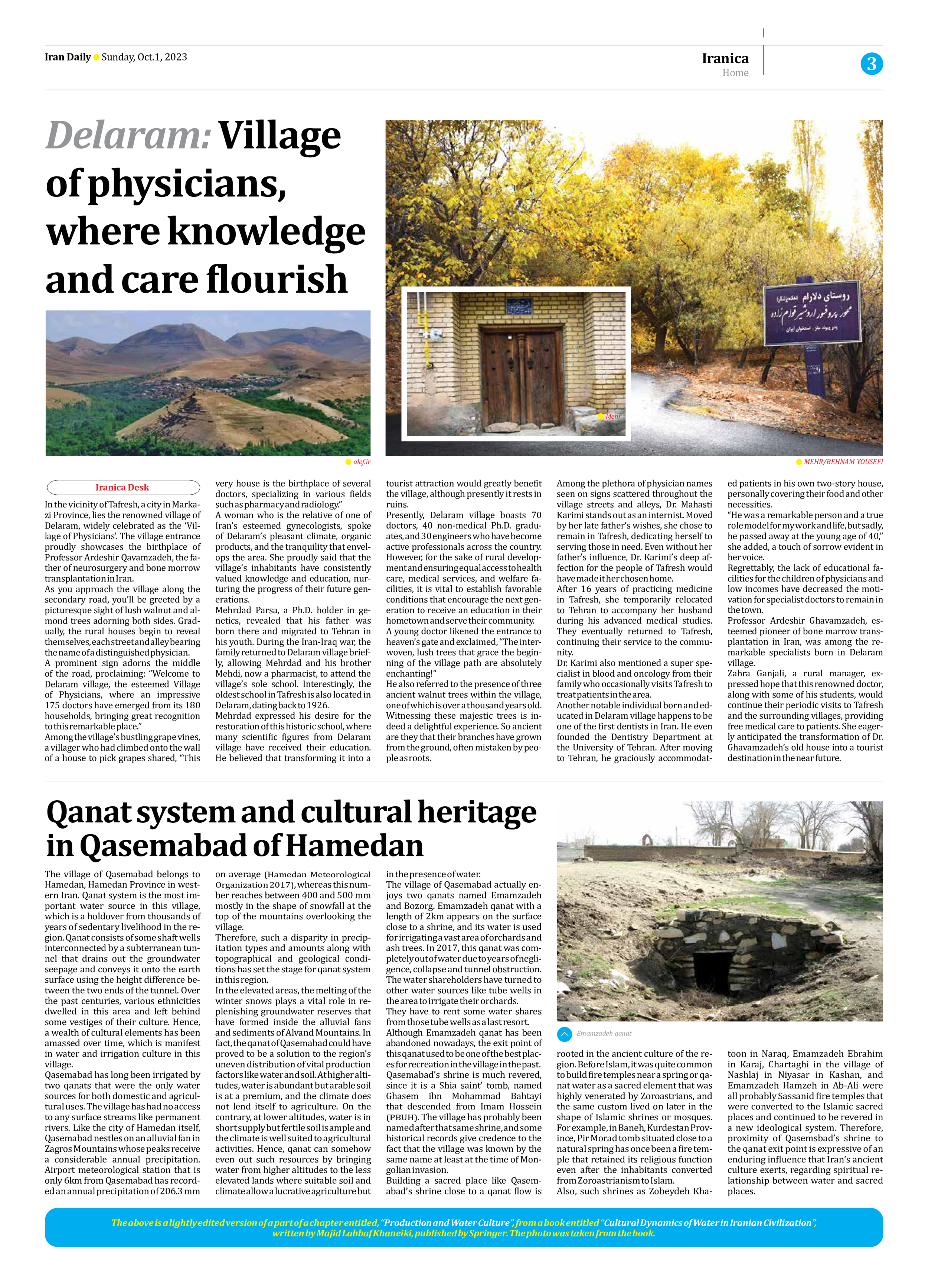
Delaram: Village of physicians, where knowledge and care flourish
In the vicinity of Tafresh, a city in Markazi Province, lies the renowned village of Delaram, widely celebrated as the ‘Village of Physicians’. The village entrance proudly showcases the birthplace of Professor Ardeshir Qavamzadeh, the father of neurosurgery and bone morrow transplantation in Iran.
As you approach the village along the secondary road, you’ll be greeted by a picturesque sight of lush walnut and almond trees adorning both sides. Gradually, the rural houses begin to reveal themselves, each street and alley bearing the name of a distinguished physician.
A prominent sign adorns the middle of the road, proclaiming: “Welcome to Delaram village, the esteemed Village of Physicians, where an impressive 175 doctors have emerged from its 180 households, bringing great recognition to this remarkable place.”
Among the village’s bustling grape vines, a villager who had climbed onto the wall of a house to pick grapes shared, “This very house is the birthplace of several doctors, specializing in various fields such as pharmacy and radiology.”
A woman who is the relative of one of Iran’s esteemed gynecologists, spoke of Delaram’s pleasant climate, organic products, and the tranquility that envelops the area. She proudly said that the village’s inhabitants have consistently valued knowledge and education, nurturing the progress of their future generations.
Mehrdad Parsa, a Ph.D. holder in genetics, revealed that his father was born there and migrated to Tehran in his youth. During the Iran-Iraq war, the family returned to Delaram village briefly, allowing Mehrdad and his brother Mehdi, now a pharmacist, to attend the village’s sole school. Interestingly, the oldest school in Tafresh is also located in Delaram, dating back to 1926.
Mehrdad expressed his desire for the restoration of this historic school, where many scientific figures from Delaram village have received their education. He believed that transforming it into a tourist attraction would greatly benefit the village, although presently it rests in ruins.
Presently, Delaram village boasts 70 doctors, 40 non-medical Ph.D. graduates, and 30 engineers who have become active professionals across the country. However, for the sake of rural development and ensuring equal access to health care, medical services, and welfare facilities, it is vital to establish favorable conditions that encourage the next generation to receive an education in their hometown and serve their community.
A young doctor likened the entrance to heaven’s gate and exclaimed, “The interwoven, lush trees that grace the beginning of the village path are absolutely enchanting!”
He also referred to the presence of three ancient walnut trees within the village, one of which is over a thousand years old. Witnessing these majestic trees is indeed a delightful experience. So ancient are they that their branches have grown from the ground, often mistaken by people as roots.
Among the plethora of physician names seen on signs scattered throughout the village streets and alleys, Dr. Mahasti Karimi stands out as an internist. Moved by her late father’s wishes, she chose to remain in Tafresh, dedicating herself to serving those in need. Even without her father’s influence, Dr. Karimi’s deep affection for the people of Tafresh would have made it her chosen home.
After 16 years of practicing medicine in Tafresh, she temporarily relocated to Tehran to accompany her husband during his advanced medical studies. They eventually returned to Tafresh, continuing their service to the community.
Dr. Karimi also mentioned a super specialist in blood and oncology from their family who occasionally visits Tafresh to treat patients in the area.
Another notable individual born and educated in Delaram village happens to be one of the first dentists in Iran. He even founded the Dentistry Department at the University of Tehran. After moving to Tehran, he graciously accommodated patients in his own two-story house, personally covering their food and other necessities.
“He was a remarkable person and a true role model for my work and life, but sadly, he passed away at the young age of 40,” she added, a touch of sorrow evident in her voice.
Regrettably, the lack of educational facilities for the children of physicians and low incomes have decreased the motivation for specialist doctors to remain in the town.
Professor Ardeshir Ghavamzadeh, esteemed pioneer of bone marrow transplantation in Iran, was among the remarkable specialists born in Delaram village.
Zahra Ganjali, a rural manager, expressed hope that this renowned doctor, along with some of his students, would continue their periodic visits to Tafresh and the surrounding villages, providing free medical care to patients. She eagerly anticipated the transformation of Dr. Ghavamzadeh’s old house into a tourist destination in the near future.







